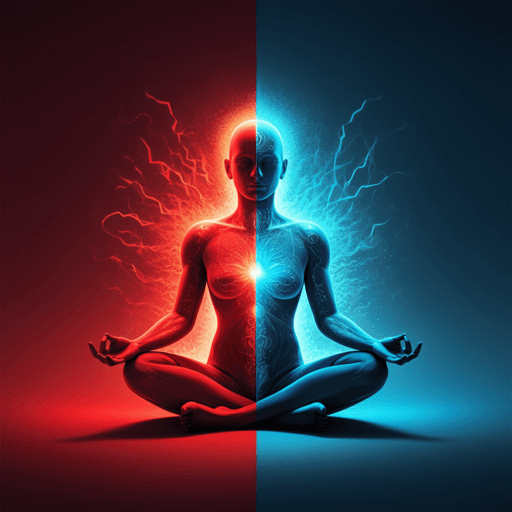
Medicine and Health
Effects of Slow Breathing Exercises on Cardiac Autonomic Functions in Anxiety Disorder—A Randomised Control Trial
N. Kavitha, P. Pal, et al.
An 8-week program of slow pranayama and savasana, added to routine psychiatric care, shifted cardiac autonomic balance toward parasympathetic predominance in anxiety disorder patients—improving HRV and baroreflex sensitivity. Research conducted by Natarajan Kavitha, Pravati Pal, Gopal Krushna Pal, Balaji Bharadwaj, and Nivedita Nanda.
~3 min • Beginner • English
Introduction
Anxiety disorders are important mood disorders commonly associated with a higher risk of fatal cardiovascular diseases (CVD), including coronary heart disease, sudden cardiac death, and cerebrovascular diseases, with a global prevalence of 0.9%–28.3%. They are characterized by autonomic symptoms such as hot flushes, palpitations, perspiration, and tremors, in addition to emotional and cognitive symptoms. Anxiety disorders lead to dysregulation of the hypothalamic-pituitary-adrenal (HPA) axis, weakening key neuronal components of the autonomic nervous system (ANS) that are involved in cardiovascular functions, thereby increasing cardiovascular risk. As per the polyvagal theory, the vagus nerve connects ANS function and social involvement; increased vagal activity encourages social participation and reduces sympathetic activity influencing emotional components regulating altruistic behaviors. Cardiovascular autonomic function tests are helpful for diagnosing cardiac autonomic neuropathy. Heart rate variability (HRV) and baroreflex sensitivity (BRS) serve as non-invasive measures of ANS activity. Optimal cardiac health is characterized by increased variability, with lower HRV linked to CVD and mortality. Impaired ANS activity—as reduced parasympathetic tone reflected in decreased HRV and BRS—is strongly associated with increased CVD risk in both psychotropic medicated and non-medicated anxiety disorders. Vagal nerve stimulation is effective in various conditions, including anxiety disorders. Slow pranayama has been shown to activate parasympathetic tone and attenuate sympathetic tone in healthy volunteers, with benefits including reduced heart rate, improved mood, cognition, and stress perception. Given the limited number of studies on slow pranayama and savasana therapy in anxiety disorder patients, this study evaluated the effects of slow pranayama and savasana on cardiac autonomic function tests in anxiety disorder patients.
Literature Review
Prior work has established that anxiety disorders are associated with diminished autonomic neurocardiac function and reduced HRV, which correlates with increased cardiovascular risk and mortality. HRV and BRS are widely accepted non-invasive indices of ANS activity; reduced values have been reported among patients with generalized anxiety disorder and related conditions. Vagal nerve stimulation has demonstrated efficacy in modulating autonomic balance in anxiety and other conditions. Slow yogic breathing (pranayama), including unilateral nostril breathing and techniques such as Bhramari and Sheetali, has been shown in healthy volunteers and various populations to increase cardiac vagal modulation (higher HF power and time-domain HRV indices), reduce sympathetic activity (lower LF and LF:HF ratio), and improve mood and stress perception. Savasana (corpse pose) has been reported to reduce diastolic blood pressure responses during stress tasks. Despite these indications, there are limited randomized trials assessing the combined effects of slow pranayama and savasana on cardiac autonomic function in anxiety disorder patients, motivating the present study.
Methodology
Study design: Randomized control trial conducted after approval from JIPMER PGRMC and JIPMER Institutional Ethics Committee (IEC approval number: JIP/IEC/2019/402), registered in the Clinical Trials Registry of India (CTRI/2021/04/033247). The study was performed in the autonomic function testing (AFT) laboratory and cardiovascular research laboratory (CVRL) at the Department of Physiology, JIPMER, Puducherry. Sample size: Calculated as 65 per group (PS software v3.1.2, α=0.05, power=80%) based on unadjusted mean difference in LF:HF ratio; with a 20% anticipated drop-out, target was 78 per group. Participants: 140 anxiety disorder patients (either sex, age 18–40 years) from psychiatry OPD at JIPMER recruited between February 2019 and January 2022; randomized via computer-based randomization to pranayama group (n=73) or control group (n=67). Completions: 59 in pranayama group and 53 in control group completed the study; dropouts (n=28) were excluded from analysis. Group allocation: Pranayama group received slow pranayama and savasana in addition to routine psychiatric care; control group received routine psychiatric care only. Inclusion criteria: DSM-5 diagnosis of anxiety disorders (including generalized anxiety disorder, panic disorder, specific phobia, agoraphobia, social anxiety disorder, unspecified/other specified anxiety disorder, anxiety due to other medical conditions, substance/medication-induced anxiety), stable on standard routine treatment; age 18–40; able to read English and/or Tamil; willing to practice pranayama; both sexes. Exclusion criteria: Known diabetes, hypertension, cardiac diseases, renal disease, other psychiatric illness, autonomic dysfunction, pulmonary disorder; prior yoga therapy. Recording procedures: After informed consent, participants reported after a light breakfast; instructions included avoiding vigorous activity for 12 h; tea/caffeine, tobacco, and alcohol for 24 h; withholding anticholinergics, antihistaminics, sympathomimetic and parasympathomimetic agents for 12 h. Recordings were obtained between 09:00–10:00 in a quiet lab at 25°C after 2 h of light breakfast. Pre- and post-intervention assessments included anthropometry and cardiovascular autonomic function tests (CAFT). Anthropometric and basal cardiovascular parameters: Height measured with stadiometer; weight with automated scale; BMI via Quetelet's index. Resting HR, SBP, DBP measured after 10 min supine rest using automated sphygmomanometer (AccuSure TMB-1490-A); MAP and RPP calculated (RPP=SBP×HR/100). Short-term HRV recording: Lead II ECG recorded for 5–10 min using BIOPAC MP36; data analyzed with BIOPAC Student Lab 4.0.0; artifacts/ectopy filtered (artifact correction <5% of beats). From 360 s ECG, R-R intervals extracted. HRV analysis: R-R tachogram interpolated at 2 Hz; FFT via Welch periodogram for spectral analysis using Kubios v2.0 (stand-alone C program compiled from MATLAB). Time-domain: Mean RR, Mean HR, RMSSD, SDNN, NN50, pNN50. Frequency-domain: Total Power (TP), LF nu, HF nu, LF:HF ratio. HR response to standing: Continuous ECG and NIBP recorded; after 10 min supine rest, participants stood within 3 s; 30:15 ratio computed as largest RR at 30th beat divided by smallest RR at 15th beat. HR response to deep breathing: Seated; deep breathing at 6 breaths/min (5 s inspiration, 5 s expiration), no breath-holding; E:I ratio computed from average maximum/minimum RR over six cycles. BP response to isometric handgrip: MVC determined; isometric handgrip at 30% MVC for 3–5 min; BP and HR measured at 1-min intervals; AΔDBP computed as maximum DBP during handgrip minus resting DBP. BRS recording: Noninvasive continuous finger arterial BP monitoring using Finometer Pro; finger pressure reconstructed to brachial arterial pressure; time-domain cross-correlation analysis of spontaneous BP and interbeat intervals; recording for 10 min supine after rest; BRS averaged and expressed in ms/mmHg. Intervention (Pranayama and Savasana): Training at ACYTER by qualified instructor for 3 supervised days in first week; then daily home practice for 8 weeks, 30–35 minutes monitored by caretaker via diary and phone calls, reinforced during OPD visits. Yoga module: Free hand exercises (2 min), slow pranayama—Anulom-Vilom (5 min), Chandranadi (5 min), Bhramari (5 min), Sheetali (5 min)—and Savasana (10 min); total ~32 min. Dropouts: Excluded from analysis; reasons included COVID-related social isolation/lockdown, medication changes during 8 weeks, inconsistent home practice. Statistical analysis: Continuous variables as mean±SD or median (range) per distribution; normality via Kolmogorov–Smirnov test. Between-group comparisons: independent t-test or Mann–Whitney U; ANCOVA controlling covariates (gender, BMI) at 8 weeks. Within-group changes: paired t-test or Wilcoxon signed-rank test. Two-tailed significance at α=0.05; IBM SPSS v22.0 used. Effect size: partial eta squared from ANCOVA (η²: 0.01 small, 0.06 medium, 0.14 large).
Key Findings
• Participants: 140 randomized; 112 completed (control n=53, pranayama n=59). Baseline anthropometric and cardiovascular measures, HRV, and CAFT were comparable between groups. • In the pranayama group after 8 weeks: significant decreases in SBP (P<.001), DBP (P<.001), MAP (P<.001), RPP (P<.001), and HR (P<.01). • In the control group after 8 weeks: HR increased (P<.05) and RPP increased (P<.01). • HRV time-domain (pranayama group, pre vs post): Mean RR increased (P<.05); SDNN increased (P<.01); RMSSD increased (P<.05); pNN50 increased (P<.05). • HRV frequency-domain (pranayama group, pre vs post): HF nu increased (P<.05); Total Power increased (P<.05); LF nu decreased (P<.05); LF:HF decreased (P<.01). • BRS: pranayama group increased significantly (P<.001), with no significant change in control. Post-intervention, BRS was significantly higher in pranayama vs control (P<.001). • Autonomic reactivity tests (pranayama group, pre vs post): 30:15 ratio increased (P<.01); E:I ratio increased (P<.001); AΔDBP decreased (P<.001). Post-intervention between-group comparisons favored pranayama: higher Mean RR (P<.01), SDNN (P<.001), RMSSD (P<.001), NN50 (P<.05), pNN50 (P<.001); higher HF nu (P<.001) and TP (P<.001); lower LF nu (P<.01) and LF:HF (P<.001); higher 30:15 (P<.001) and E:I (P<.01); lower AΔDBP (P<.001). • Effect sizes (ANCOVA partial η²): large effects for weight, BMI, HR, RPP, SDNN, LF nu, HF nu, LF:HF, 30:15, and BRS. Overall, slow pranayama with savasana shifted autonomic function toward parasympathetic predominance and reduced sympathetic activity in anxiety disorder patients.
Discussion
The findings demonstrate that adding slow pranayama and savasana to routine psychiatric care in anxiety disorder patients produces significant autonomic modulation favoring parasympathetic tone, alongside reductions in sympathetic markers. Decreases in SBP, DBP, MAP, and RPP indicate lowered sympathetic drive and reduced myocardial workload, while the reduction in resting HR reflects increased vagal influence. Time-domain HRV increases (Mean RR, SDNN, RMSSD, pNN50) and frequency-domain shifts (higher HF nu and TP, lower LF nu and LF:HF) collectively show enhanced cardiac vagal modulation and attenuated sympathetic tone, improving the sympathovagal balance. Improved vagal reactivity (higher 30:15 and E:I ratios) and reduced sympathetic reactivity (lower AΔDBP) further corroborate a functional shift toward parasympathetic predominance. The significant increase in BRS indicates a strengthened baroreflex arc and improved cardiovascular homeostasis, a marker associated with reduced cardiovascular risk. These results align with prior studies in healthy volunteers and other populations showing that slow breathing practices enhance vagal activity and reduce sympathetic activation, and that savasana provides additional relaxation-driven autonomic benefits. Proposed mechanisms include mechanical and neural effects of slow deep breathing that synchronize central autonomic circuits and shift autonomic balance, and relaxation-mediated modulation of respiratory frequency impacting cardiac autonomic modulation. By mitigating HPA axis activation associated with anxiety, pranayama and savasana may restore autonomic homeostasis, translating to improved cardiovascular parameters and potentially reduced CVD risk in anxiety disorders.
Conclusion
Slow pranayama and savasana, implemented as adjuncts to routine psychiatric care, effectively improve cardiac autonomic function in anxiety disorder patients, producing a shift toward parasympathetic predominance and significant improvements in cardiovascular parameters (HRV, BRS, blood pressure, and rate pressure product). Given these benefits and large effect sizes on key autonomic markers, integrating slow pranayama with savasana into routine clinical management of anxiety disorders may enhance cardiovascular health. Future research should consider longer follow-up, multiple assessment time points within the intervention period, and designs that further minimize bias (e.g., assessor blinding), as well as exploring dose–response and generalizability across different anxiety diagnoses and age groups.
Limitations
A double-blinded design was not feasible due to the nature of the yoga intervention, which prevents participant blinding. Outcomes were not assessed at multiple time points within the 8-week period; more frequent assessments could provide finer temporal resolution of changes. There were dropouts related to COVID-19-related social isolation/lockdown, medication changes, and inconsistent home practice, which may affect generalizability, although dropouts were excluded from analysis.
Related Publications
Explore these studies to deepen your understanding of the subject.







